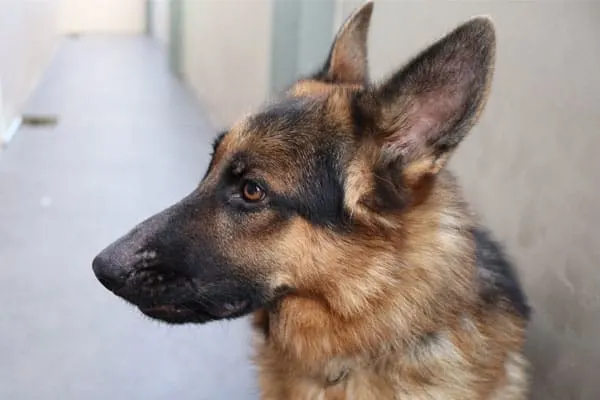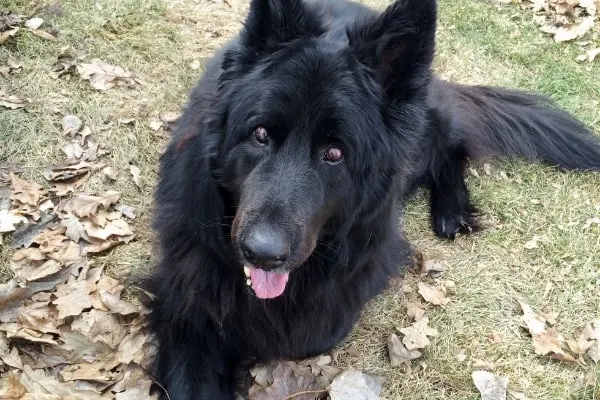Are German Shepherds Color Blind: What We Know and What We Don’t About GSD Vision
The German Shepherd dog has many amazing talents and skills. These dogs are incredible athletes with keen hearing and super-sharp noses.
But eyesight isn’t one of the GSD’s finest senses. The same holds for all canines. Dogs just don’t have the keenest vision in the world of animal species.
But is German Shepherd dog vision worse than the rest? Are German Shepherds color blind?
In this article, we take a close look at the topic of GSD vision, how your German Shepherd dog sees the world, and what is similar and different about what they see.

Are German Shepherds Color Blind? No, But Sort Of
Rewind a century or so ago, and canine biologists were fairly certain dogs were color blind.
As the American Kennel Club (AKC) explains, this early reasoning was based on research about human color blindness.
Thanks to an early dog enthusiast named Will Judy, who founded and wrote for a dog magazine back in the 1930s, people got the impression that all dogs are color blind, which means they see in only the black and white spectrum of colors.
Modern canine biologists have since disproven this assumption, and this time there is solid research to back it up.
There is even something called the Dog Vision Image Processing Tool to help people see the world approximately the way the world sees it.
You can try this tool out for yourself with any photo you’ve taken to see how your dog might see the same scenery you are both looking at. The results are rather remarkable!

If German Shepherds Are Not Color Blind Then What Do They See?
As canine expert and Psychology Today writer Dr. Stanley Coren explains, dogs do see some colors.
But as you just saw for yourself if you tried out the Dog Vision Image Processing Tool in the previous section here, the colors your GSD sees don’t look like the colors you see.
The colors your German Shepherd sees are duller, less vibrant, less rich in hue, and far less sharp and detailed.
Why is this the case? Is there something wrong with dogs’ eyes?
There isn’t anything wrong with the canine eye. It is just made differently from your eyes and the eyes of other animals. To understand why your dog’s eyes see the way they see, you need to understand more about how eyes are made.
Eyes have something called cones that can perceive, pick up, and process different color spectrums. There are three main types of cones (blue, green, red) that can pick up different types of colors.
Eyes also have something called rods, which pick up light and motion.
To understand what is different in your GSD’s eyes than in your own eyes, you need to know that you have more types of cones in your eyes (three versus two) but your dog has more rods in their eyes (up to five times more).
This means that while you can see colors a lot better, your dog can see much better in low light conditions. Some dog breeds are even specifically bred to hunt and work at night for this reason!
This short and simple video helps break down these differences between the canine eye and the human eye is a clear and easy language.

The German Shepherd Eye Sees Yellow and Blue Colors Very Well
Much like people are said to be red-green color blind when they cannot pick up colors in this spectrum, German Shepherds could be said to be red-green color blind.
So what does your German Shepherd see when they are looking at something that is in the red or green color spectrum?
According to VCA Animal Hospital, when your dog looks at something in the red color spectrum, what they will see will look more like a dark brown or black.
When your dog looks at something that is in the green color spectrum, what they will see will likely look yellowish.
But this does not mean they are truly color blind. Your German Shepherd can see colors in the yellow and blue spectrum fairly well given their more limited number of cones per eye.
The fewer cones mean that blue and purple likely look quite similar (if not identical) to your dog. In the same way, yellow and orange most likely look like the same color when your GSD looks at it.

Other Important Differences in the German Shepherd Dog Eye Vs Your Eye
But how you and your dog see the world differently is not just limited to a different number of rods and cones.
There are some other important and interesting differences you may also want to be aware of.
Eye placement in your GSD’s eyes
For example, have you ever thought about how your eyes are both placed on the front of your head, relatively close together?
Compare this with how your German Shepherd’s eyes are placed. Your dog’s eyes are placed more on the sides of their head.
This difference in placement adds up to mean that your GSD has a much better range of peripheral (side) vision than you do. Your GSD can see things “out of the corner of their eye” that you would miss.
No wonder German Shepherds are often chosen for protection and guard duty – they don’t miss anything!
Greater pupil dilation in your GSD’s eyes
Another key difference between your eyes and your German Shepherd’s eyes is that your dog’s pupils are capable of dilating to a greater degree than your own.
This enhanced dilation means they can use their rods to the max to soak in the light and see even in dim conditions.
Special reflective cells underneath your GSD’s retinas
Still another important difference between your own eyes and your dog’s eyes is that your GSD has special reflective cells placed underneath each retina.
This special reflective area is called the tapernum. It is also there to help your dog see better in low light conditions.
All of this means that dogs are vision-optimized to see better than their people in three specific situations:
- Low light
- Dim light
- Motion
Think back to when humans and canines were partnering up in centuries past. With humans who could see better during the day and dogs that could see better at dawn, dusk, and after nightfall, both species gained more protection from predators.

Why It is Helpful to Know How Your GSD Sees the World
It can certainly be interesting to learn more about how your German Shepherd sees the world and experiences life through their eyes.
But does this information have some greater use? In other words, what does all this information mean for you?
Choose toys in the yellow and blue spectrum
One thing it means is that you can maximize what your GSD can see by choosing toys that are made with the yellow and blue color spectrum.
These toys may be more appealing to your dog and may also encourage more interaction and play activity.
This can be particularly helpful if your German Shepherd has packed on the pounds and you are trying to encourage more play and exercise for weight loss.
It can also help lessen frustration during training and play because you now realize if you choose training aids in a color spectrum your dog cannot see, you may not get the responses you are hoping to get until you choose different colors.
Choose color over light to increase training responses
As a new study published in the Proceedings of the Royal Society B Journal explains, dogs are much more likely to quickly recognize objects based on color rather than light.
Of course, the researchers only chose objects in the blue and yellow color spectrum for this experiment. But it does show that your GSD’s eyes may be more keenly interested in the color of something than in the amount of available light to see that object.
Better understand your dog’s distractions for training and play
If your dog seems easily distracted by small, fast-moving objects, whether that is a squirrel in a nearby tree, a lizard on the ground, or a bird flying overhead, this is because of your German Shepherd’s increased ability to see and sense motion optically.
To make sure your dog stays focused on you (and only you) place yourself directly in front of your GSD during training and play.
Dogs and people have shared life for literally tens of thousands of years. While in some ways this has made humans and canines more alike, in other ways we will always be different.
Ultimately, the more effort you make to experience how your German Shepherd sees and experiences the world, the closer you will feel to your dog, and the more you can enhance their enjoyment of life.






























